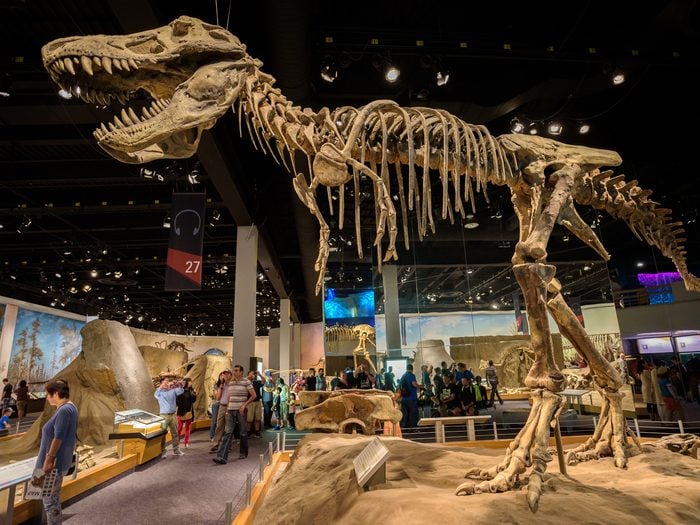
Dinosaur Fossils Across Canada
From skulls to footprints to fully-formed skeletons, dinosaur fossils give us a chance to imagine what Canada might have felt like during the Mesozoic era when remarkable reptiles roamed the land.
And roam our land they did. Across Canada, paleontologists have identified more than 100 different species of dinosaurs. While most were discovered in Alberta, a bona fide hot spot of dino activity, you can find evidence of our prehistoric past in protected parks and ecological reserves, as well as preserved and displayed in museums in every province across the country.
Here are the best places in each province to get your fill of dinosaur fossils.
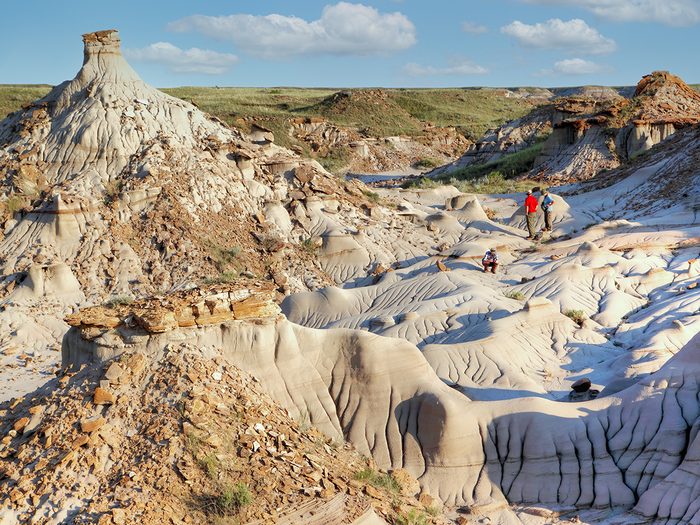
Alberta: Dinosaur Provincial Park
Dinosaur Provincial Park is the place to go for fossil finders and dinosaur hunters alike. After 130 years of excavations, 55 different dinosaur species and more than 150 complete dinosaur skeletons have been found here. Guided tours at this park two hours east of Calgary take you to the bone beds (disorganized concentrations of bones in the ground), where you can find your own dinosaur fossils and learn more about your discoveries using the park’s dinosaur checklist.
Be sure to bring your camera. Located in the heart of Alberta’s Badlands, this UNESCO World Heritage Site offers some of the most breathtaking scenery in Canada, including hoodoos, which are tall sandstone rock spires formed by erosion.
Tip: Book your tours and accommodations well in advance. Dinosaur Provincial Park is a popular spot—for good reason: This ancient place provides the most complete record of the late Cretaceous Period. The land will transport you back in time to when these sandy valleys were lush, green and teeming with dinosaurs.
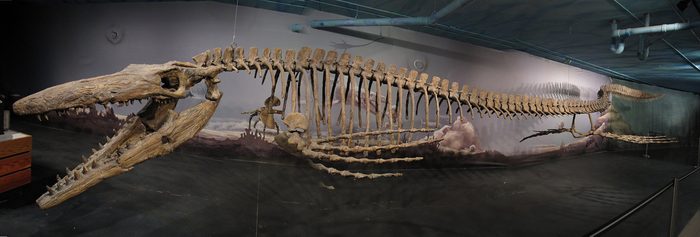
Manitoba: Canadian Fossil Discovery Centre
Fascinated by the ferocious toothed beasts that ruled the seas during the late Cretaceous period? You’re going to want to meet Bruce: a 13-metre long Tylosaurus pembinensis that towers over the Canadian Fossil Discovery Centre (CFDC) in Morden, Manitoba. Bruce, the world’s largest publicly displayed mosasaur, once haunted the depths of Earth’s Western Interior Seaway, eating everything and anything in its path, including sharks, birds and even other mosasaurs.
At the CFDC, you’ll also have the chance to see Canada’s largest collection of marine reptile fossils and an amazing diorama depicting the local animal life of the time, including plesiosaurs and mosasaurs (like Bruce) and early sharks, squid, birds and turtles.
Check out more hidden gems across Canada.
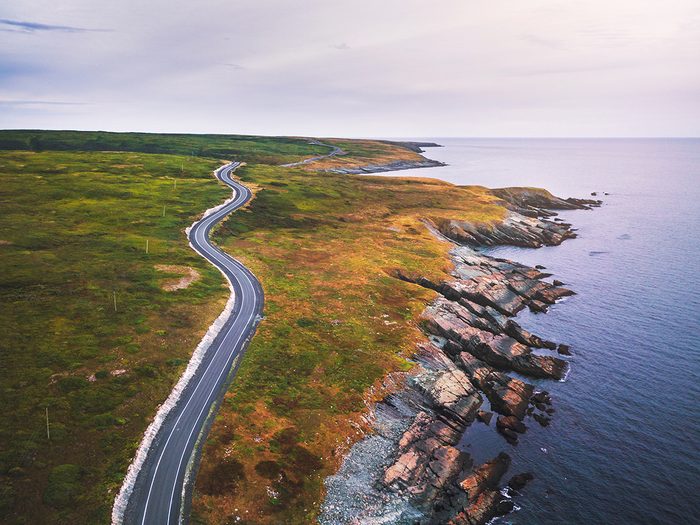
Newfoundland and Labrador: Mistaken Point Ecological Reserve
You may not find any actual dinosaur fossils at Mistaken Point Ecological Reserve, a UNESCO World Heritage Site, but you will find evidence of their great-great-great-great-great grandparents (also known as the planet’s earliest large, complex, multicellular creatures).
Take a guided tour to the south-eastern tip of Newfoundland to see wonderfully preserved fossils of the creatures that were kicking around more than 565-million years ago (that’s hundreds of millions of years before the dinosaurs) when all life was in the sea. It’s also the only place in the world where you can see 565-million-year-old deep-sea floors—each layer of rock is a page from a book documenting the origins of life on this planet.
After, you can head on over to the nearby Cape Race lighthouse, which received the first distress call from the Titanic in 1912.
Here are 10 historical landmarks every Canadian needs to visit.
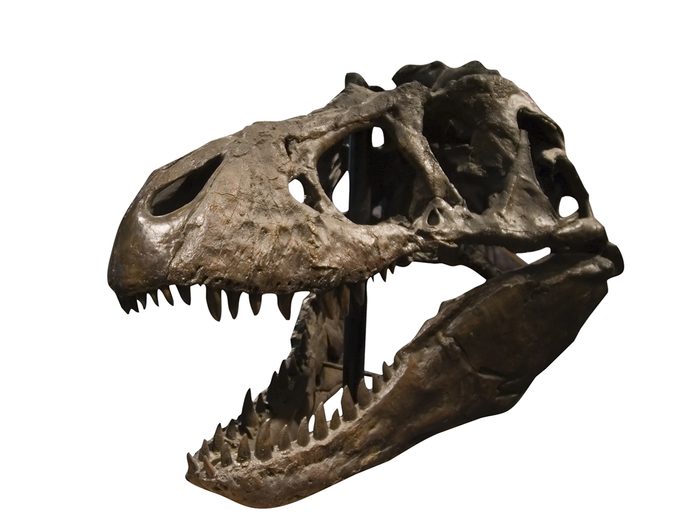
Saskatchewan: T. rex Discovery Centre
In case the name didn’t give it away, the T. rex Discovery Centre in Eastend, Saskatchewan, is the place to be if you’re a fan of ferocious theropods. When standing in the shadow of Scotty, the world’s biggest Tyrannosaurus rex, you’ll understand what it must have felt like to be a tasty little Triceratops.
Scotty’s story is a fascinating one: the 66-million-year-old T. rex was discovered in 1991 by high school teacher Robert Gebhardt, who joined palaeontologists on an expedition on the Frenchman River Valley to learn more about fossil identification and discovery. Well, Gebhardt sure learned a lot that day: he found both a small piece of a tooth and vertebra from a tail.
The full excavation of the gigantic predator happened three years later and provided valuable information about both the T. rex and Cretaceous Saskatchewan in general.
Fossil records show the region was home to both carnivorous and herbivorous dinosaurs, including horned dinosaurs like Triceratops (aka the T. rex’s favourite meal) and duck-billed dinosaurs.
Discover 20 mind-blowing things you’ll find in Canadian museums.
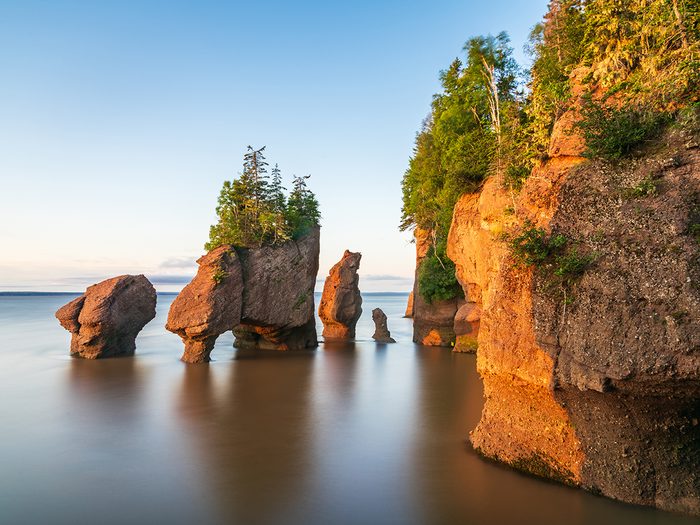
New Brunswick: Hopewell Rocks Provincial Park
If you want to learn about life before the dinosaurs and discover some of the world’s oldest fossils, add the Bay of Fundy to your bucket list. Over time, powerful tides have shaped the bay’s coastline and exposed fossils from distant periods of Earth’s history. It’s no surprise it’s considered one of the natural wonders of the world.
At Hopewell Rocks Provincial Park you can walk out on the ocean floor at low tide and experience dramatic cliffs, sea stacks and caves that are usually underwater. There, you can also examine ocean life in tidal pools. You may even be one of the lucky few to make a Triassic age fossil discovery. The park has produced fossils of the creatures that competed with the early dinosaurs, including the skull of a beaked archosaur called Teraterpeton.
Check out the best caves to explore across Canada.
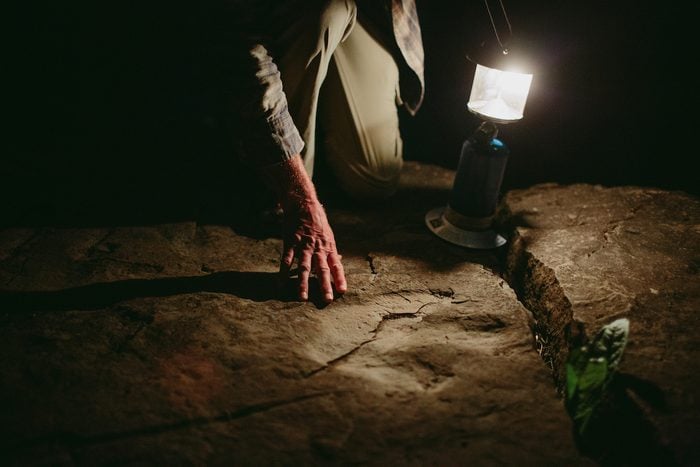
British Columbia: Tumbler Ridge Museum
British Columbia’s dinosaurs may not have been as numerous as Alberta’s, but they were certainly great at hiding. Most evidence of the province’s rich dino history wasn’t discovered until the year 2000 when some kids happened to discover a dinosaur “trackway” while tubing at Tumbler Ridge, at the base of the B.C. Rockies. (Trackways are trace fossils that capture things like footprints and tail drag marks that show evidence of an ancient creature’s passage.)
This chance discovery was the catalyst for other important finds in the Tumbler Ridge region. Today, visitors can still see the northernmost Brontosaurus prints, the only known Tyrannosaur trackway in the world, as well as the only known footprints of the carnivorous Therizinosaur. You can sign up for a guided tour and learn all about the region’s outstanding trackway and fossil heritage at the Tumbler Ridge Museum.
Tip: Don’t miss the Tumbler Ridge Museum’s night tours. If you think 97-million-year-old fossilized dinosaur footprints are a sight to behold during the day, wait until you see them in lantern light!
Discover more hidden gems in British Columbia.
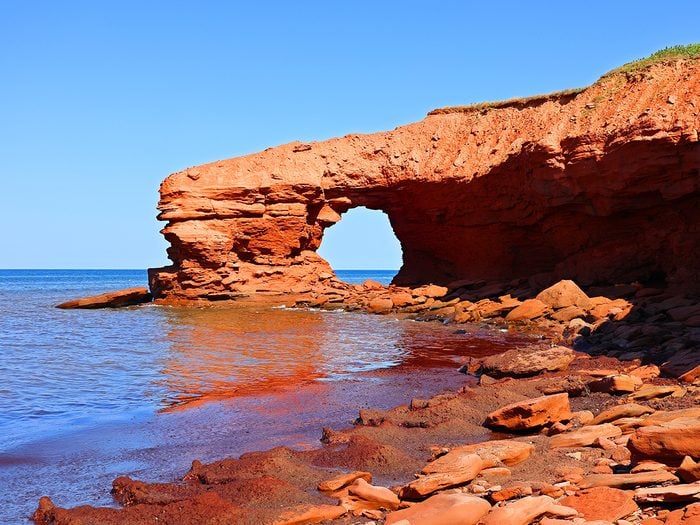
Prince Edward Island: P.E.I. National Park
Prince Edward Island’s red sandstone cliffs are more than just an awe-inspiring natural wonder: the iconic cliffs, made up of layer upon layer of sedimentary rock, also offer clues to the province’s prehistoric past.
As the coast erodes over time, more rock is exposed, and with it, more history—including fossils. It’s no surprise P.E.I. holds Canada’s only fossil record of life on land in the Permian period. About one inch of rock is equal to about a thousand years of time.
While you won’t see any of P.E.I.’s impressive fossils on display in the province, you just might discover some of your own while visiting P.E.I. National Park, which extends along the island’s north coast from Cavendish to Dalvay. The park is home to the aforementioned cliffs and has been the epicentre of major fossil finds, including the skull and footprints of Dimetrodons, the extinct relatives of primitive mammals.
Don’t miss these mind-blowing Canadian geography facts.
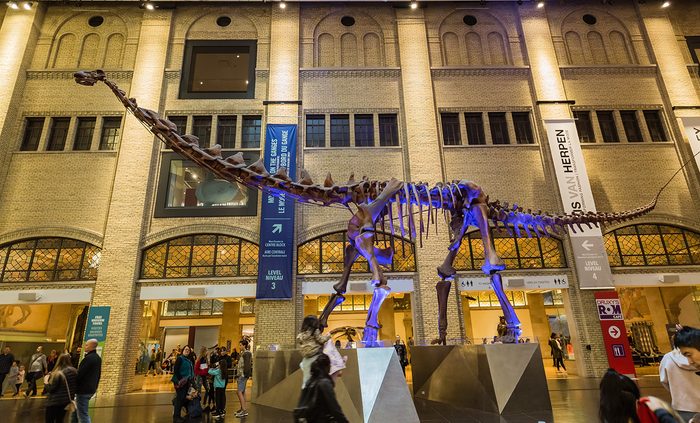
Ontario: Royal Ontario Museum
Dinosaur lovers flock to the Royal Ontario Museum (aka the ROM) in Toronto to experience an incredible gallery bursting with both iconic and unusual dinosaur fossils.
The fun starts at the main entrance where the Futalognkosaurus (above) greets visitors as they get the lay of the land. But it doesn’t stop there. The ROM boasts one of the world’s most impressive dinosaur fossil collections, which includes the world’s best preserved specimen of a Parasaurolophus, a duck-billed hadrosaur.
Just don’t miss the main event: Gordo the Barosaurus, at 27 metres long, is the largest dinosaur skeleton mounted in Canada made of real fossil bones and not replica casts.
You’ll also love spotting the classics, like the Tyrannosaurus rex, Stegosaurus, and Triceratops who call the ROM home.
Here are 10 quirky Canadian museums worth adding to your itinerary.
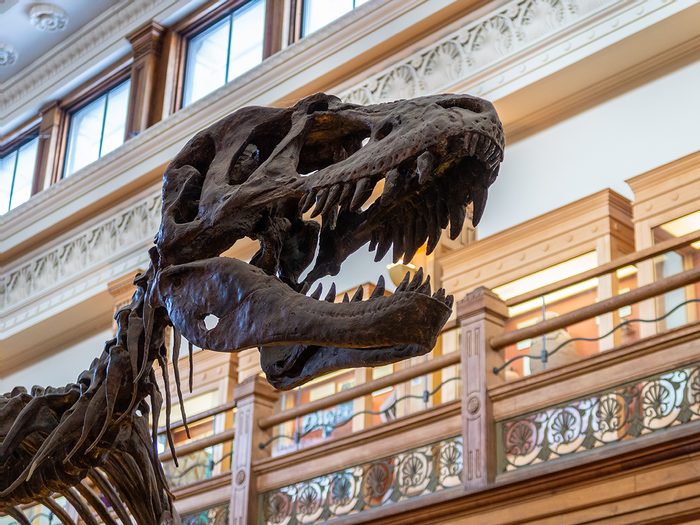
Quebec: Redpath Museum
The Redpath Museum is the oldest building in Canada, so it’s only fitting it’s used to house fossils of reptiles that are hundreds of millions of years old. Located on McGill University’s campus in downtown Montreal, the museum features a full-size Gorgosaurus libratus (a tyrannosaurid theropod that lived in western North America, above), a Dromaeosaurus albertensis (a relative of the Velociraptor) and skulls of a Tyrannosaurus rex and Triceratops.
The museum also offers a fascinating look at life in Canada back when it was still sandwiched right up against Greenland, Portugal, Spain and Morocco as part of a single supercontinent known as Pangea. Fossil specimens show evidence of everything from the first animal life that transitioned from the sea onto land in the Gaspé Peninsula to the strange creatures that arose from the Cambrian explosion in the Rocky Mountains.
Here are more hidden gems in Quebec that are worth exploring.
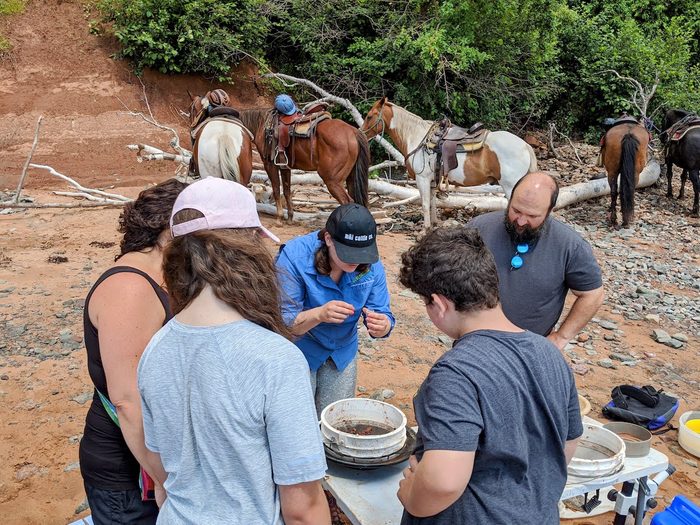
Nova Scotia: Fundy Geological Museum
The Fundy Geological Museum’s dinosaur bones are so ancient, they make other fossils seem young by comparison.
At the museum, located in Parrsboro, Nova Scotia, you’ll have a chance to learn about some of the ancient dinosaurs that roamed the Earth at the end of the Triassic period (you’ll find fossils of the prosauropod Plateosaurus engelhardti, a bulky herbivore that walked on two legs) to the dinosaurs that emerged after the mass extinction at the end of the Cretaceous period. The museum also offers beach tours where you’ll have a chance to look for fossil footprints as you soak up the beauty of the surrounding bluffs.
For more family-friendly adventures, check out Canada’s best indoor amusement parks.